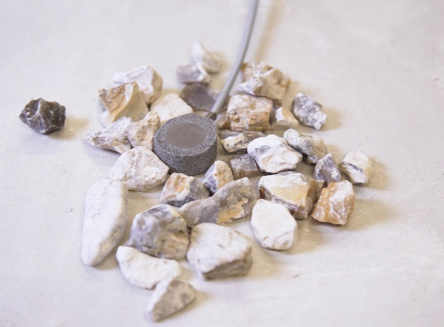Dans la même rubrique
-
Partager cette page
Embedded piezoelectric transducers for ultrasonic monitoring of concrete structures [Offre de Technologie]
The technology in a nutshell
The development of low-cost ultrasonic piezoelectric transducers to be embedded in concrete with applications in the field of non-destructive testing techniques (estimation of material properties from the very early age) and structural health monitoring (damage detection, on-line monitoring of civil infrastructure).
State of the art
Ultrasonic testing of concrete is an established non-destructive testing technique allowing to estimate mechanical properties as well as the damage state of concrete. Current commercial solutions rely on external transducers which need to be held manually on the external surface of concrete and can therefore not be used for continuous and remote monitoring in the laboratory or in the field.
The invention
Embedding the ultrasonic transducers in the concrete structure (at the time of construction, or later if the structure already exists) brings many advantages compared to the traditional external transducers such as a better signal-to-noise ratio due to the excellent coupling with the host material, repeatability of the measurements, protection from external factors, as well as the possibility to arrange the wave paths in a much more flexible way (not limiting the transducers to the outer surface, which is often not accessible). As the monitoring can be performed remotely, it is an ideal solution in hazardous environments such a nuclear power plants.

Key advantage of the technology
- Excellent signal-to-noise ratio
- Repeatability of the measurement
- Possibility of remote and automated continuous monitoring
- Low-cost
Potential application
The transducers can replace external transducers in laboratory applications such as the estimation of wave velocity in concrete or acoustic emission monitoring. They can be used to monitor continuously the state of concrete in long tests such as freeze-thaw cycling or drying tests, as well as very short resistance tests (cylinder compression, bending tests, …). They have also proven to be effective for on-line monitoring of civil engineering concrete infrastructure to provide real-time data to the company responsible for the maintenance, even in hazardous or inaccessible locations.
Technology readiness level

The transducers are fully functional. They have been used on site for automated monitoring of parts of the concrete ceiling of the Rogier tunnel in Brussels after repairs. They have been implemented in June 2019 and are still currently delivering on-line information about the state-of-health of the concrete.
The team
The vibrations laboratory is part of the inter-disciplinary civil engineering group BATir in the Brussels School of Engineering at ULB. The team is working on applications related to structural dynamics with a focus on non-destructive techniques using both advanced numerical techniques and state-of-the-art testing equipment.
The inventors

Prof Arnaud Deraemaeker was born in 1974. He graduated from the Brussels School of Engineering in 1998 as a civil engineer, and obtained his PhD thesis from Ecole Normale Supérieure de Cachan (France) in mechanical engineering in 2001. He has a widely recognized expertise in the field of structural dynamics with applications related to structural health monitoring, damage detection, development of piezoelectric transducers and modeling and optimization of active and passive structures for vibration damping. He published 1 book, 6 chapters of books and more than 50 journal papers related to various applications and developments in his field.
Relevant publications
- Embedding ultrasonic transducers in concrete: A lifelong monitoring technology. A. Deraemaeker and C. Dumoulin. Construction and Building Materials, 194:42–50, 2019.
Keywords
- Embedded Transducers
- Ultrasonic Testing
- Concrete monitoring
Collaboration type
- Licence agreement
- R&D collaboration
IP status
Inventors
- Pr Arnaud Deraemaeker
- Dr Cédric Dumoulin
Contact
ULB Research Department
Arnaud Quintens
Business developer
+32 (0)2 650 96 78
arnaud.quintens@ulb.be
